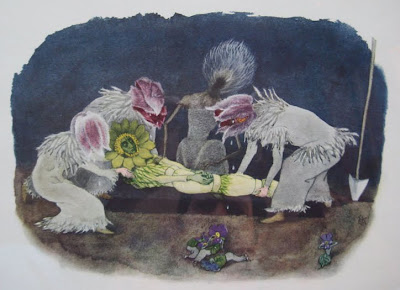Buon anno a tutti!
guarda il quadro
ascolta la musica




Giorgio da Castelfranco detto Giorgione
(Castelfranco Veneto 1478 – 1510)
Laura 1506
Kunsthistorisches Museum, Vienna Austria
Nothing is sure about Giorgione, his birth date and his name are uncertain, his works are uncertain, no one of them are signed, their meaning is uncertain, enigmatic and almost indecipherable. Genius and mystery.
We don't know anything about this woman identity too. She looks straight forward and it is difficult to identify negative or positive feelings, maybe pride shines through. Maybe she is a Venetian whore , you may tell this looking at her dress with fur that was used by the Venetian whores, and looking at the laurel used in the antiquity for its prophylactic characteristics.
Laurel leaves were chewed by the pizie (female priests) of Apollo temple because they thought this plant was hallucinogenic, able to inspire prophecy.
Di Giorgione nulla è certo, incerta è la sua data di nascita e il suo nome, incerte sono le sue opere, nessuna d’esse è firmata, incerto è il loro significato, enigmatico e per certi versi indecifrabile. Il genio, il mistero.
Anche l’identità di questa donna non è dato sapere. Posta di tre quarti, guarda dritto davanti a sé ed è difficile scorgere in lei qualche sentimento negativo o positivo, semmai traspare la fierezza. Forse si tratta di una prostituta veneziana, lo proverebbe la veste con pelliccia in uso fra le meretrici lagunari, e lo stesso alloro che nell’antichità era noto per le sue proprietà profilattiche.
Foglie di alloro erano anche masticate dalla pizie (le sacedotesse) del tempio di Apollo, a Delfi, in quanto si riteneva questa pianta avesse proprietà allucinogene, capaci di ispirare la profezia.
Try the recipe / prova la ricetta
Listen to the music / ascolta la musica

Try the recipe / prova la ricetta
“Colombo“ è il secondo singolo del quarto album dei Baustelle Amen (2008) premiato con la Targa Tenco per il miglior album dell'anno.
Il brano è ispirato al famoso Tenente Colombo dell’omonima serie televisiva americana e parla dell'ipocrisia delle classi agiate.
www.baustelle.it
Try the recipe / Prova la ricetta
Watch the painting / Guarda il quadro


Vincenzo Campi
Try the recipe / prova la ricetta
Autunno è un brano tratto dall'album Stagioni (2000) di Francesco Guccini
Francesco Guccini (Modena, 14 giugno 1940) è un musicista, scrittore ed è fra i più importanti e noti cantautori italiani. Il suo debutto ufficiale risale al 1967 con l'album Folk beat n.1 (ma già nel 1960 aveva scritto L'antisociale); in una carriera ultraquarantennale ha pubblicato oltre venti album di canzoni. I testi dei suoi brani vengono spesso assimilati a componimenti poetici e denotano una familiarità con l'uso del verso tale da costituire materia di insegnamento nelle scuole come esempio di poeta contemporaneo.
Try the recipe / prova la ricetta
Watch the painting /guarda il disegno
Nanni Svampa (Milan February 28th 1938) is an Italian singer, writer and actor. He founded the musical and cabaret group The Owls. He translated a lot of Brassens's songs.
“Old times funerals” is s a cover of Georges Brassens's "Les Funerailles D'antan"
Nanni Svampa (Milano, 28 febbraio 1938) un cantante, scrittore e attore italiano, fondatore del gruppo musicale e cabarettistico I Gufi.
"Funerali D'altri Tempi" è una cover di Georges Brassens's "Les Funerailles D'antan"
Watch the painting / guarda il quadro
Try the recipe / prova la ricetta

Try the recipe / prova la ricetta

Patty Pravo, art name of Nicoletta Strambelli, is a famous Italian singer born in Veneto Region, Venice on April 9th 1948. She spent her youth in Venice with her grandmother and since she was very young she studied dance, piano and attended a course of orchestra leader too. Afterwards she spent some time in London and then she moved in Rome where she started to have success under the name of Guy Magenta. It is in the legendary Piper Club cult place of that period that she was discovered by the manager Alberigo Crocetta. The choice of her art name was made by the singer and it refers to Dante's Inferno. She has a very long and musical lucky carrier with the publication of 18 long player records from 1968 to 1990 and 10 cd from 1994 to 2011.
Wonderful Thought is a song of 1978.
http://www.coltempo.it/biografia/biografia.htm
Patty Pravo, nome d'arte di Nicoletta Strambelli è una famosa cantante nata a Venezia il 9 aprile del 1948. Trascorre i primi anni dell'adolescenza a Venezia con la nonna e fin da piccolissima studia danza e pianoforte, seguendo anche un corso di direzione d'orchestra. Successivamente trascorre del tempo a Londra e poi si trasferisce a Roma, dove comincia a farsi notare col nome di Guy Magenta. È al leggendario Piper Club, luogo di culto e autentico simbolo di un'epoca, che viene scoperta dal manager Alberigo Crocetta. La scelta del cognome d'arte Pravo, viene fatta dalla cantante in riferimento all'Inferno dantesco ("guai a voi anime prave", cioè malvagie). Ha una lunga e fortunata carriera musicale con la pubblicazione di 18 33 GIRI dal 1968 al 1990 e 10 cd dal 1994 al 2011.
http://www.coltempo.it/biografia/biografia.htm
Watch the painting / guarda il quadro